 Logo handmade by Bannister
Column by Scott Green
Logo handmade by Bannister
Column by Scott Green
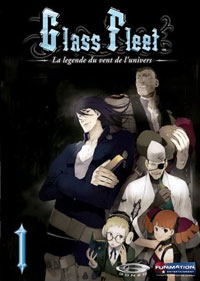
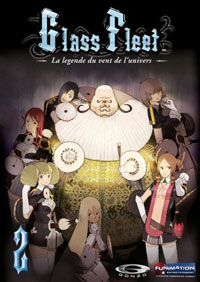
Anime Spotlight: Glass Fleet Volumes 1 and 2 Released by FUNimation
Glass Fleet definitely isn't a "steam punk space opera", but that aggregate label suggests the general idea at work in the series. It opens with a well-heeled space-noble sipping tea in a monumental library as he philosophizes. From his wonderings at the number of lives lost to the capriciousness of the universe, the anime cuts to the decisive battle that set the stage for its central conflict. Squadron after squadron of battle ships form 100 vessel grids in front of a floating mountain range. Though the exteriors of these ships aren't that far from the typical, metallic idea of a space ship, inside they are full of manual workings and Babbage style computer systems. Men in 18th century military regalia meet in marble chambers to make their final plans. Then, the opposing lines of ships begin to pass through each other, firing mid-20th century style turrets. When the battle ends, Vetti Lunard Sforza de Roselait has been declared Holy Emperor and a new oligarchy has replaced the defeated assembly of noble families. In response to the corruption of Vetti's regime, Michel Volban de Cabelle raises up a People's Army to revolt. Initially, this opposition is little more than a nuisance. The People's Army is far outmatched by Vetti and his fleets. However, Michel becomes swept up with the motley crew of the titular (literally glass) ship, the captain of which is Cleo of the Wind, a pirate and claimed descendant of the exiled royal family, with intentions of supplanting the strongest party around. If you watch a lot of anime, the elements involved in these events provoke comparisons to a couple of noteworthy series that haven't, and given the nature of the market, probably won't be released in the US. Even if Glass Fleet is tipping its tricorne in the direction of Napoleonic France (with more than a glance toward the Italian Renaissance), it does recall shoujo classic Rose of Versailles (and its descendant, Chevalier d'Eon). In that tradition, Michel immediately begins provoking some gender ambiguity questions. As, does Vetti's uncomfortably young male named advisor/consort. At the same time, while its military action is decidedly incredible, politics and nods toward strategy feel reminiscent of Legend of Galactic Heroes, a set of novels and gigantic work of anime (110 OVA episodes, plus 52 side story OVA episodes) telling a sci-fi war based on 19th century Prussian conflicts. The intention of this column's reviews is not to categorize anime based on an evaluation of what is worth purchasing, what is worth renting, and what is worth avoiding. With that out of the way, now is the time to point out that the most satisfactory way to experience Glass Fleet would probably be to rent it, or through iTunes if it becomes one of FUNimation's titles to be offered through that service. The Gonzo (Afro Samurai, Samurai 7, Basilisk)/Satelight (Noein, Aquarion, Arjuna) collaboration produces a rigorously designed, imaginative space-opera. Everywhere you look, it is unconventional. The thought and care that went into the production is deeply evident. Unfortunately, it is also a profoundly flawed work. Gonzo is typically accused of having certain problems in their anime productions. Satelight on the other hand is more given too contraversial works (the upcoming Macross F should be interesting). Glass Fleet's problems could easily be attributed to the Satelight side of its parentage, which is to say that Glass Fleet is a bold miss. Satelight's body of work suggests an interest in provocative, unusual concepts. So, rather than falling into the rut of problematic sci-fi anime where either nothing new is offered or what is new is abandoned in favor of conventional standbys, Glass Fleet fully commits. Except, it generally doesn't have what is needed to succeed in place. Case for case, either they've invested in notions that aren't going to resonate, or put forward implementations that don't click. On the micro-level, the anime is peppered with hard earned "almost"'s. The problem is that all of that work doesn't always produce something spectacular. A space ship is taken to a planet where it is sold for scrap and fed into a wrecking machine. It's a marginally interesting idea, and it is captured in a way that can fire up a sci-fi fan's interest in large scale happens. Except, the decision to use a press evokes the idea of crushing cars and deflates the spectacle. Especially compared to the real work of ship breakers, it seems anticlimactic. By the same token, the next episode features an amazingly long sword fight. Again, it is well animated. It eschews the frequently used flash-of-light shorthand. There's plenty of movement, plenty of interaction with the environment, plenty of dynamic energy. But, it's not well choreographed. A sense of redundancy to the attack and dodge patterns removes any excitement. On the macro level, the nature and depiction of the conflict is lacking. In this decade, don't you expect a sci-fi fan to be cynical or at least critical? Glass Fleet isn't aimed at an audience that is especially young, nor is it magical enough to cause an older audience to suspend disbelief. Early in the first episode, the anime depicts space ships firing shells with people manually loading the batteries then covering the ears to avoid the deafening shot and, it has winches manually powered by galley slaves. Leiji Matsomoto got away with space-zeppelins and space-galleys and flags furling in the vacuum between stars. But, his adamant willed heroes stared physical impossibility in the eyes without blinking. There's a sense of mechanism in Glass Fleet that doesn't play into the Matsumoto-verse myth making. Glass Fleet wants to have a system for how its space travel and warfare works, unfortunately, it doesn't make much sense factually or within the context of the anime. You don't need to buy into the argument that sf consumers are more discerning than most to wonder what the producers were thinking here. The anime is oblivious to the needs of the audience regarding justification and sorely lacking a reason to believe in what it is depicting. The flip side is that when Glass Fleet stops trying to be amazing, it gets quite good. It takes a while for the anime to establish its who's who, but once that is in place, the landscape of intertwining agendas becomes intriguing. The last episode of the second volume features Vetti and his advisor as well as Michel and Cleo negotiating with a powerful third party. The balance of temperaments, priorities and abilities between the different cadres makes for a fascinating, prolonged exchange. The talkier that Glass Fleet gets, the more its unique aspects become its strength. Even if Glass Fleet is a particularly MST3K worthy anime series, you have to feel bad about ripping it. Agree with their sentiments or not, Satelight tends to display some convictions in their anime. There's little lazy and conventional about Glass Fleet. It would take an unusual set of tastes to really love the series, but, even if you find the content entirely unagreeable, it is at least interesting for what it tries to do.
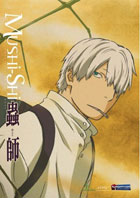
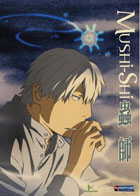
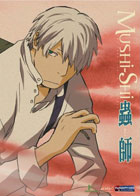
Anime Spotlight: Mushi-shi Volumes 2-4 Released by FUNimation
For a jaded anime fan, the field can start to look like a stagnant puddle with a bit of an oil slick, representing the marginally more inventive anime. Yet, Mushi-shi is one of the works that confounds this general pecimism towards the medium. Both in Japan and in North America, the series has grabbed plenty of attention through its idiosyncratic storytelling. It's been a magnet for grand pronouncements, and basically, for American commentators, the No Country for Old Men of anime in 2007: a minute minority loathed it, the rest have it in on their top 10 lists for the year. And, it is that good. Mushi ("bugs") are organisms far removed from familiar classifications, distant from the ones that can be seen with the naked eye: animals, plants, fungus, and just as far removed from the microscopic kingdoms. They make what could be called an organic spiritual world of ghosts, living rainbows, sense stealing oozes, flowers that cause one to live a lifetime during the course of a day and butterflies that cause humans to hibernate. Though there is no maliciousness or even judgment on the part of the mushi, when their live cycle intersect with human endeavors, the outcome often resembles the effects of a curse. The episodic anime (and before that, "Kodansha Manga of the Year" winning manga), follows the work of Ginko. He's a mushi-shi, which is to say that he has the rare ability to see mushi, and has specialized in mastering their lore. In his specific case, he's become a wandering scientific investigator, problem solver, shaman, and occasionally quack. In each episode, Ginko interacts with a specific set of people, with a specific mushi-related concern. There is a doctor of conventional medicine that Ginko visits several times, and mentions a few more, generally because the man is a connoisseur of mushi-related artifacts, and therefore fractionally a colleague, a vehicle of supplementary income, and maybe a smidge of a dupe. Though one of these episodes is a Ginko origin story, there is no real plot development throughout Mushi-shi. More than that, the structure of this work is antithetical to the advancement or progress that is common in popular anime series. Mushi-shi seems outside of time. Ginko is traveling through a pre-modern world, and as such, he spends long stretches stuck in one place: on islands waiting for seasonal tides, locked in snowy mountains, on the wrong side of a collapsed bridge. And, the anime is not concerned with demonstrating that the character is growing older or personally advancing. Maybe, it is possible to construct a logical timeline for Ginko's work, but that seems to be far removed from the point. Even in the origin story, he's really a catalyst that acts on events without essentially becoming part of them. For an anime fan that expects a 26 episode series to go someplace, this is a liability. In the minds of many, anime that doesn't move a plot has become associated with extraneous "filler". Mushi-shi is not a Case Closed/Detective Conan, but, in the minds of some, it might suffer a similar reaction to what that series faced. Even if Mushi-shi doesn't work with a complex, long form narrative with evolving, developing characters, the obvious reason to watch the anime is its exquisitely beautiful animation. Half of this is a worldly beauty. The anime devotes itself to creating the identity of specific, often remote locations. A sense of place is essential to what Mushi-shi is about, and as such, each episode builds out at least one environment. From episode to episode, it almost takes on the role of travelogue. Whether it is a barren, rocky island or a verdant, green mountainside, the anime captures the full look and breath of each place. The other side of the accomplished animation is the otherworldly mushi. The approach here is to take something natural and make it alien, either shifting the context, such as jellyfish and ameba moving through the air or giant insects walking over tree-tops, or animating the inanimate, such as dancing mushrooms or rushing vines. These shifted impressions give an eerie sense of something ethereal overlapping the material world. Like some of the scariest moments in the pre world-gone-to-hell phase of Berserk, it seems like there is something existing just outside the corner of your eyes that is immense and potentially dangerous. Except, Mushi-shi is more than just pastoral beauty and spooky mystery. As a narrative device, the mushi serve to create fairytales for the modern world. There's a notion of concrete science coupled with unbound questioning. On one side, Ginko is solving cases by experimentally proving his hypotheses. On the other, what he is working with often seem to be the answers to a child's "why" questions. Often he's chasing rainbows and looking for the other side of a shadow. But, this is as much a vehicle as Ginko's character. Besides exploring Zen questions, such as "what's left inside a cocoon when a moth hatches," there is a powerful relevance to these stories. Many distill themselves to questions about how to live life with challenges, relating to past mistakes, disability or loss. Mushi-shi is far from humorless, but it is sober. Few anime take such an unblinking look at matters like illness and suffering.
ASTRO BOY Marathon on Adult Swim - Dec. 25-26, 2007
Cartoon Network's Adult Swim will be running a marathon of the classic Astro Boy starting at 11 p.m. EST on Christmas night (Dec. 25 / tomorrow), with "The Birth of Astro Boy" and continues through the early morning hours of December 26. This is the 1963 series, released on DVD in North America by Right Stuf
